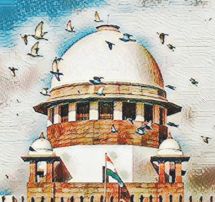Every monsoon, India’s cities are brought to a standstill by waterlogging. Justice Markandey Katju examines the roots of this recurring urban crisis – and why urgent action is needed.
WIRH THE COMING of the monsoon rains in North India, the curse of waterlogging in our cities has once again descended upon us.
In the national capital Delhi and its neighbouring areas, heavy waterlogging has again made the lives of travellers on the roads miserable and hellish.
 The recent rains in Delhi, Mumbai, Kolkata and other cities have caused havoc on the streets. YouTube and Facebook are full of photographs and videos of waterlogged roads.
The recent rains in Delhi, Mumbai, Kolkata and other cities have caused havoc on the streets. YouTube and Facebook are full of photographs and videos of waterlogged roads.
Vehicular traffic has been severely affected, power supply disrupted in many places, trains and flights cancelled, rescheduled or diverted, and the lives of citizens thrown out of gear.
The misery that has unfolded is, of course, not unique to Delhi, Mumbai and Kolkata. All across India – from Srinagar to Punjab, from Chennai and Mumbai to Dibrugarh – rain is inevitably followed by waterlogging on city streets, causing immense suffering to the people.
In September 2014, heavy rains turned the capital of Jammu and Kashmir into a lake, with many localities submerged under 20–30 feet of water.
In my hometown of Allahabad, localities like Allahpur and Mumfordganj often go 10 feet under water every year after heavy rains. Kolkata’s waterlogged streets are well known, and parts of Delhi, such as Minto Bridge, face severe waterlogging during the monsoons.
 The current situation in Punjab underscores the urgent issue: continuous heavy rain and overflowing rivers have created one of the worst floods in decades—nearly 30 lives lost, more than 2.5 lakh people displaced, and widespread inundation of both farmland and urban areas like Ludhiana, now submerged under 2–3 feet of water.
The current situation in Punjab underscores the urgent issue: continuous heavy rain and overflowing rivers have created one of the worst floods in decades—nearly 30 lives lost, more than 2.5 lakh people displaced, and widespread inundation of both farmland and urban areas like Ludhiana, now submerged under 2–3 feet of water.
What is the cause of this?
The reason is simple to understand: urban greed has destroyed our drainage systems.
Rains come every year during the monsoon season, and so there must be a proper drainage system to carry water from the streets to nearby rivers; otherwise, it accumulates and causes waterlogging.

Drains In The Indus Valley Civilisation
Historically – right up to British rule and for some time thereafter – there were excellent drainage systems in every city in India, properly maintained by the municipalities.
Thus, we read in our history books of excellent drainage systems in the cities of the Indus Valley Civilization 5,000 years ago.
Gradually, however, in recent decades, people, in their greed, have illegally built houses, shops and other structures over the drains – obviously in collusion with municipal officials – thereby blocking them everywhere.
Our ancestors of the Indus Valley Civilization built cities and towns with excellent drainage and sewage systems 5,000 years ago. Five thousand years later, have we in India moved forward or backward?
In Srinagar, people illegally filled up both banks of the Jhelum River with earth and built houses and other buildings on them, narrowing the width of the river. Obviously, it will overflow during the rains.
Why did the authorities allow this to happen? Clearly, money must have changed hands.
To make matters worse, successive governments at the Centre and in the states have not bothered to invest in urban infrastructure – especially drains, pipelines and sewerage systems – despite the growing population of our towns and cities.
What is the remedy for this malady?
Several PILs have been filed in the past in connection with the waterlogging problem in India in various High Courts (Delhi, 2012; Cuttack, 2007; Patna, 2012; Delhi, 2013, etc.). To my knowledge, the Indian Supreme Court has not heard such petitions. In Bangladesh, however, the Supreme Court has weighed in on the problem.
 To my mind, when our Supreme Court can take suo motu cognizance of the menace of stray dogs, it can surely do the same with respect to the much bigger problem of waterlogging in many cities every year, and issue directions to the government to do the needful.
To my mind, when our Supreme Court can take suo motu cognizance of the menace of stray dogs, it can surely do the same with respect to the much bigger problem of waterlogging in many cities every year, and issue directions to the government to do the needful.
In various decisions, the Supreme Court has held that the right to life guaranteed by Article 21 of the Constitution means a life of dignity, and not just an animal existence.
Thus, in Chameli Singh vs. State of U.P. (1995), the Supreme Court observed:
“In any organised society, the right to live as a human being is not ensured by meeting only the animal needs of men. The right to live implies the right to a decent environment, medical care, food and shelter. These are the basic human rights known to any civilized society. The civil, political, social and cultural rights enshrined in the Universal Declaration of Human Rights, the Human Rights Convention and the Constitution of India cannot be exercised without these basic human rights.

To my mind, a PIL should be filed immediately in the Supreme Court, and the Court should appoint a committee consisting not only of officials but also of technical experts and responsible citizens of the affected cities, empowering it to take suitable action to deal with the flood and waterlogging situation on a war footing.
Anyone who has studied history knows that our ancestors of the Indus Valley Civilization built cities and towns with excellent drainage and sewage systems 5,000 years ago. Five thousand years later, have we in India moved forward or backward? ![]()
_______
Also Read:
Silencing Journalism: Pressure Tactics and Law
Drowning in Our Own Concrete Jungle
Disclaimer : PunjabTodayNews.com and other platforms of the Punjab Today group strive to include views and opinions from across the entire spectrum, but by no means do we agree with everything we publish. Our efforts and editorial choices consistently underscore our authors’ right to the freedom of speech. However, it should be clear to all readers that individual authors are responsible for the information, ideas or opinions in their articles, and very often, these do not reflect the views of PunjabTodayNews.com or other platforms of the group. Punjab Today does not assume any responsibility or liability for the views of authors whose work appears here.
Punjab Today believes in serious, engaging, narrative journalism at a time when mainstream media houses seem to have given up on long-form writing and news television has blurred or altogether erased the lines between news and slapstick entertainment. We at Punjab Today believe that readers such as yourself appreciate cerebral journalism, and would like you to hold us against the best international industry standards. Brickbats are welcome even more than bouquets, though an occasional pat on the back is always encouraging. Good journalism can be a lifeline in these uncertain times worldwide. You can support us in myriad ways. To begin with, by spreading word about us and forwarding this reportage. Stay engaged.
— Team PT

